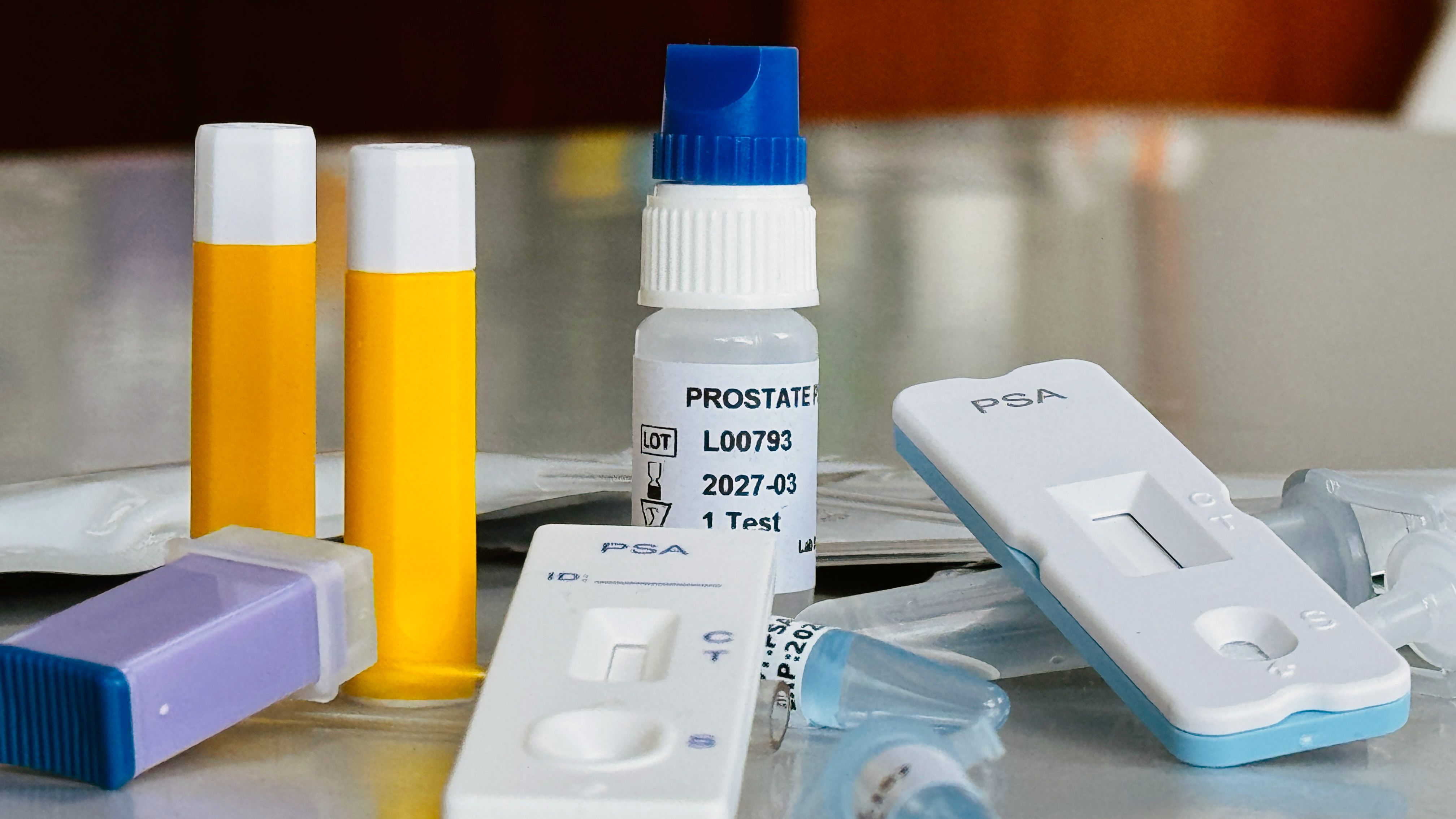Prostate cancer is the most common cancer among those assigned male at birth. The Centers for Disease Control and Prevention (CDC) reports that out of every 100 people with penises, about 13 will develop prostate cancer during their lifetime.
A common first step in screening for prostate cancer is the PSA test. PSA is a protein produced by the prostate, the small gland located below the bladder.
Elevated PSA levels can sometimes indicate prostate cancer, but a high PSA isn’t specific to cancer. PSA may also rise with benign prostatic hyperplasia (an enlarged prostate), infections, and prostatitis (inflammation of the prostate).
A PSA test alone cannot diagnose prostate cancer, but it can prompt a discussion with a clinician about prostate health. Depending on the results, a doctor may recommend additional diagnostic testing.
While PSA testing traditionally required a lab or clinic visit, at-home PSA kits are now available.
Read on to learn more about PSA testing and where to obtain at-home kits.
Types of PSA tests

PSA exists in the bloodstream in two main forms. One form, complexed PSA, is bound to proteins. The other form, percent-free PSA, circulates unbound.
A routine PSA test usually measures total PSA — the sum of both bound and free forms. If total PSA is outside expected limits, physicians may order measurements of specific PSA fractions to help decide whether a biopsy is warranted.
Percent-free PSA test
If total PSA falls into a borderline range (typically between 4 and 10 ng/mL), clinicians may request a percent-free PSA test. A lower percent-free PSA is associated with a higher likelihood of prostate cancer.
The American Cancer Society generally recommends that people with a percent-free PSA of 10% or less consider biopsy.
Complexed PSA test
Complexed PSA refers to PSA that is attached to proteins. This test can be used instead of measuring total PSA, although it is less commonly employed.
Other types of tests
Testing technology continues to advance. Several newer assays integrate different PSA measurements to create a combined score that estimates cancer risk. These include:
- Prostate Health Index (PHI): Merges total PSA, percent-free PSA, and proPSA (an immature PSA form).
- 4Kscore Test: Combines total PSA, percent-free PSA, complexed PSA, human kallikrein 2 (hK2), and additional variables.
Should you get a PSA test?
Most people with penises will have a PSA test at some point. Depending on age and risk profile, your provider may recommend screening.
In 2018, groups such as the U.S. Preventive Services Task Force (USPSTF) issued guidance for those thinking about screening.
The USPSTF advises the following for people at average or elevated risk who have no symptoms and have never been diagnosed:
- Aged 55 to 69: Make an individualized choice about PSA screening.
- Discuss the potential benefits and harms of screening, diagnosis, and treatment with your clinician before deciding.
- Age 70 and older: Routine screening is not recommended if you have no symptoms or other significant risk factors.
The USPSTF also recommends considering the following when discussing screening with your doctor:
- family history of prostate cancer
- African American race
- other medical conditions that could complicate treatment if cancer is detected
- your personal valuation of the possible benefits and harms of screening, diagnosis, and treatment
Healthline’s picks for the best at-home PSA tests
Comparing PSA tests
Test
Testing location
Results time
Price
at home
5 days
$185.84
• Labcorp testing centers
• at home
• 1 to 2 days
• up to 5 days
$69
How we chose the best home PSA tests
We picked these PSA kits based on factors we believe reflect safety, quality, and transparency.
We only list tests that send samples to certified laboratories, and we periodically re-evaluate the products to ensure we recommend high-quality options for readers.
In our review process, we considered:
- the company’s reputation and business practices
- product composition and overall quality
- any third-party validations
- lab result accuracy
- marketing claims
Learn more about how we evaluate at-home health tests.
How to choose an at-home PSA test
When selecting a PSA kit, consider:
- whether the provider uses CLIA-certified laboratories
- turnaround time for results
- which PSA markers are assessed
- ease of use
- how convenient it is to mail your sample
- cost
- what follow-up support the company offers
What do PSA test results mean?
Results report PSA concentration in ng/mL. PSA interpretation is debated because there’s no single universally accepted cutoff.
The National Cancer Institute explains there is no absolute threshold that separates “normal” from “abnormal.” Traditionally, a PSA of 4 ng/mL or more suggests increased prostate cancer risk, but it doesn’t confirm cancer. The American Cancer Society notes that a portion of people with PSA below 4 will still have prostate cancer.
Age-adjusted cutoffs are often used since PSA tends to rise with age. Various medications, supplements, health conditions, and procedures can also influence PSA, including:
- testosterone
- finasteride
- dutasteride
- aspirin
- statins
- diuretics
- tobacco
- prostatitis
- enlarged prostate
- prostate biopsy
- prostate cystoscopy
- urinary tract infection (UTI)
According to Zero Cancer, general PSA guidelines are:
- 0 to 2.5 ng/mL is considered typical.
- 2.6 to 4 ng/mL is typical for many, but you should discuss your risk factors with a clinician.
- 4.0 to 10.0 ng/mL may indicate a higher likelihood of prostate cancer — about a 25 percent chance.
- 10.0 ng/mL and above warrants immediate discussion with a clinician — roughly a 50 percent chance of cancer.
When to see a doctor
If your PSA is high, schedule an appointment with a clinician. Elevated PSA by itself does not diagnose a specific condition because multiple prostate issues can raise PSA.
Further evaluation can help determine the cause of the increased levels and enable early treatment if needed.
About prostate cancer
Age and genetics significantly influence prostate cancer risk. If relatives on either side of your family have had prostate cancer, your risk increases. According to research, African American men face a higher risk of developing prostate cancer.
Studies indicate that this elevated risk may stem from a mix of factors, including access to care, stage at diagnosis, comorbidities, socioeconomic status, and geography.
Prostate cancer often progresses slowly, but it can be lethal depending on stage at detection. Some forms are aggressive, which is why early detection is important.
Are at-home PSA tests reliable?
At-home PSA kits send samples to CLIA-approved labs, often the same facilities used by clinicians and public agencies. Still, the PSA test is not infallible as a cancer screen, though it can serve as a useful starting point.
Elevated PSA does not necessarily mean cancer; benign conditions like BPH or prostatitis can also raise levels.
When PSA is elevated, physicians commonly follow up with imaging (such as ultrasound) and biopsy to confirm a diagnosis.
Conversely, PSA testing can also miss some cancers. The NHS notes that PSA does not catch all cancer types. The ACS states that a portion of people with PSA below 4 will still have prostate cancer.
PSA tests are a reasonable first step for higher-risk individuals but are not definitive. As with any home kit, at-home PSA results may not match those obtained in clinic settings.
Several factors can transiently raise PSA before testing, including:
- physical exertion
- testosterone therapy
- urinary retention
- urological procedures
- recent ejaculation
- conditions such as prostatitis or enlarged prostate
- older age
Some things can lower PSA, such as certain medications and supplements, including:
- 5-alpha reductase inhibitors
- herbal blends
- thiazide diuretics
- aspirin
- cholesterol-lowering drugs
What are the benefits and risks of a PSA test?
PSA testing can increase the chance of detecting prostate cancer before it spreads. At-home kits may encourage individuals who wouldn’t otherwise see a clinician to begin screening and discuss results with a provider.
However, routine PSA screening is no longer universally endorsed because detecting more cancers does not always translate into better survival for everyone.
The CDC warns that false positives can lead to unnecessary anxiety and procedures, like biopsies, which carry risks.
Some prostate cancers are so small they would never cause symptoms or threaten life, and diagnosing these can result in overtreatment with avoidable complications. The CDC notes that identifying such cancers can lead to more medical harm than benefit for some.
Possible treatment side effects include:
- urinary incontinence
- erectile dysfunction
- bowel issues
If you’re unsure about treatment, consider a second opinion and weigh treatment risks and benefits carefully.
Frequently asked questions about PSA tests
What PSA level indicates cancer?
No single PSA value confirms prostate cancer, but a PSA of 4.0 ng/mL or higher is linked to an increased risk. Elevated PSA often prompts a repeat test, a digital rectal exam, or a biopsy to clarify the cause.
What are normal PSA levels by age?
Research suggests typical upper PSA limits by age are:
- 40 to 49: 2.5 ng/mL
- 50 to 59: 3.5 ng/mL
- 60 to 69: 4.5 ng/mL
- 70 to 79: 6.5 ng/mL
These ranges generally apply to White populations. Black individuals often have naturally higher PSA readings. These ranges also may not reflect transgender, nonbinary, gender nonconforming, or other gender-diverse people.
Your medical history, risk factors, and symptoms will influence whether further evaluation is recommended.
What is an alarming PSA level?
The National Cancer Institute considers PSA above 4.0 ng/mL to be “abnormal,” though age-based adjustments are common. Some clinicians use a higher cutoff for older patients (e.g., 5 ng/mL) and a lower cutoff for younger patients (e.g., 2.5 ng/mL).
Medications like finasteride and dutasteride can lower PSA, which may require adjusted interpretation.
If PSA falls between 4 and 10, the ACS labels this the “borderline range” — roughly a 1 in 4 chance of prostate cancer. PSA levels above 10 raise the estimated probability to about 50 percent.
What should you avoid before a PSA test?
Prostate Cancer UK recommends avoiding the following for 48 hours before a PSA test:
- strenuous exercise like cycling
- sexual activity resulting in ejaculation
Avoid anal sex or prostate stimulation for a week prior to testing. Discuss any medications with your clinician before testing, since some drugs can raise or lower PSA and affect results.
Takeaway
PSA testing can offer useful preliminary information about prostate health. Though not perfect, PSA results can be helpful to clinicians when combined with medical history and other findings.
A PSA test can bring reassurance and may help avoid an immediate invasive biopsy. Still, it’s important to consult a clinician through the process because false positives and negatives occur, and PSA is influenced by many health and lifestyle factors.


















Leave a Reply
You must be logged in to post a comment.